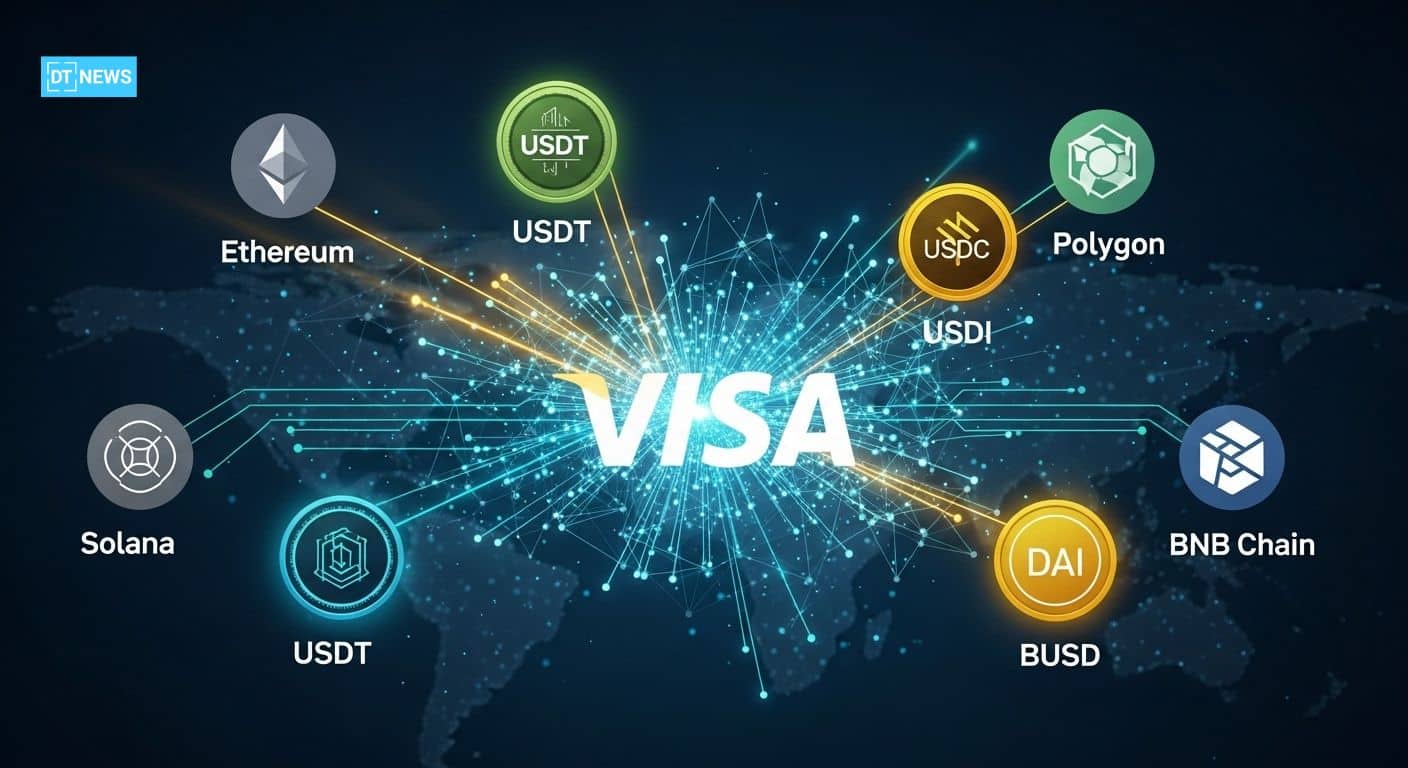This article was first published on Deythere.
Visa is expanding its stablecoin capabilities to support four more stablecoins across four different blockchains, with the ability to convert into more than 25 fiat currencies. This comes as Visa reports stablecoin-linked card spending grew four times year-over-year in the last quarter.
During the Q4 earnings call, CEO Ryan McInerney said: “We’re adding four stablecoins, on four different blockchains, two currencies we can accept and convert to over 25 traditional fiat currencies.”
The move means Visa is going to embed blockchain-enabled digital assets deeper into its global payments infrastructure.
What Visa is Announcing
The Visa stablecoin expansion framework will allow banks and clients to mint and burn their own stablecoins via its Tokenized Asset platform and settle across multiple chains. They already support stablecoins like USD Coin (USDC), Euro Coin (EURC), PayPal USD (PYUSD) and Global Dollar (USDG) on Ethereum, Solana, Stellar and Avalanche.
The new rollout will add four more stablecoins on four different blockchains, though the tokens and networks weren’t disclosed.
This builds on Visa’s previous stablecoin-linked card spend which is an annualized run rate of $2.5 billion.
Why This Matters for Payments and Stablecoins
Visa’s move comes as stablecoins are gaining momentum in both retail and institutional markets. Since 2020, Visa has facilitated over $140 billion in crypto and stablecoin flows.
The fourfold increase in stablecoin-linked card spending in the last quarter shows the use-cases for stablecoins are expanding beyond trading into everyday payments and cross-border flows.
By supporting multiple blockchains and stablecoins, Visa is reducing settlement friction, broadening channel access and increasing global liquidity across chains.
How the Multi-Chain Model Works
In practice, Visa’s model will work across three parts: distribution, settlement and bank-issued tokens. Banks can mint and burn stablecoins via Visa’s tokenized asset layer.
Settlement will span multiple blockchains; the current ones (Ethereum, Solana, Stellar, Avalanche) plus the four new tokens to convert to over 25 fiat currencies.
Visa is integrating these flows into its Visa Direct services for stablecoin-prefunded cross-border payments. McInerney said:
“We expanded the number of stablecoins and blockchains available for settlement and monthly volume has now passed a $2.5 billion annualized run rate.”
The Ecosystem Impact of the Visa Stablecoin Expansion
According to Visa’s head of crypto, this is particularly important in emerging markets where dollar access is limited and stablecoins can be liquidity bridges.
For merchants and financial institutions, multi-chain stablecoin settlement means faster settlement times, potential cost savings and global reach without relying on correspondent banking systems.
The expanded support also means Visa expects more regulation and clarity around stablecoins; the US GENIUS Act helped with that.
What to Watch
The four new stablecoins on four blockchains presents many questions. Industry observers would watch to see which blockchains are added and which stablecoins are chosen. How banks adopt minting/burning and how Visa integrates these flows into its global agent and merchant networks.
Card-linked stablecoin spend and cross-border use cases are expected to grow. Additionally, regulatory clarity and compliance frameworks will determine how fast this scales globally.
With stablecoin volumes already surpassing traditional rails in some markets, Visa’s move could change the payments scope.
Glossary
Stablecoin: A cryptocurrency pegged to a fiat currency or asset to maintain a stable value.
Tokenized Asset Platform: A framework that lets financial institutions mint and manage blockchain-based tokens; representing assets or currencies.
Minting / Burning: The process of issuing (minting) or destroying (burning) tokens; often used to manage supply.
Cross-border Settlement: The process of settling financial transactions between parties in different jurisdictions; or currencies.
Visa Direct: Visa’s platform for real-time or near-real-time funds transfers and payments.
Frequently Asked Questions About Visa Stablecoin Expansion
What is the Visa stablecoin expansion?
It’s Visa’s plan to support four new stablecoins on four different blockchains, convert to more than 25 fiat currencies and allow bank minting/burning via its tokenised asset platform.
Why is Visa expanding stablecoin support now?
Visa says stablecoin-linked card spend has quadrupled this year and digital asset flows are growing and there’s more regulation around stablecoin issuance.
Which blockchains and stablecoins are part of the expansion?
Visa didn’t say. It currently supports USDC, EURC, PYUSD and USDG on Ethereum, Solana, Stellar and Avalanche. The expansion will add four new stablecoins and four new blockchains.
What does “banks minting and burning stablecoins” mean?
It means banks will be able to issue (mint) or redeem/destroy (burn) their own stablecoins using Visa’s tokenized asset platform, so they have control over issuance and supply for payments and settlement purposes.



















































































































